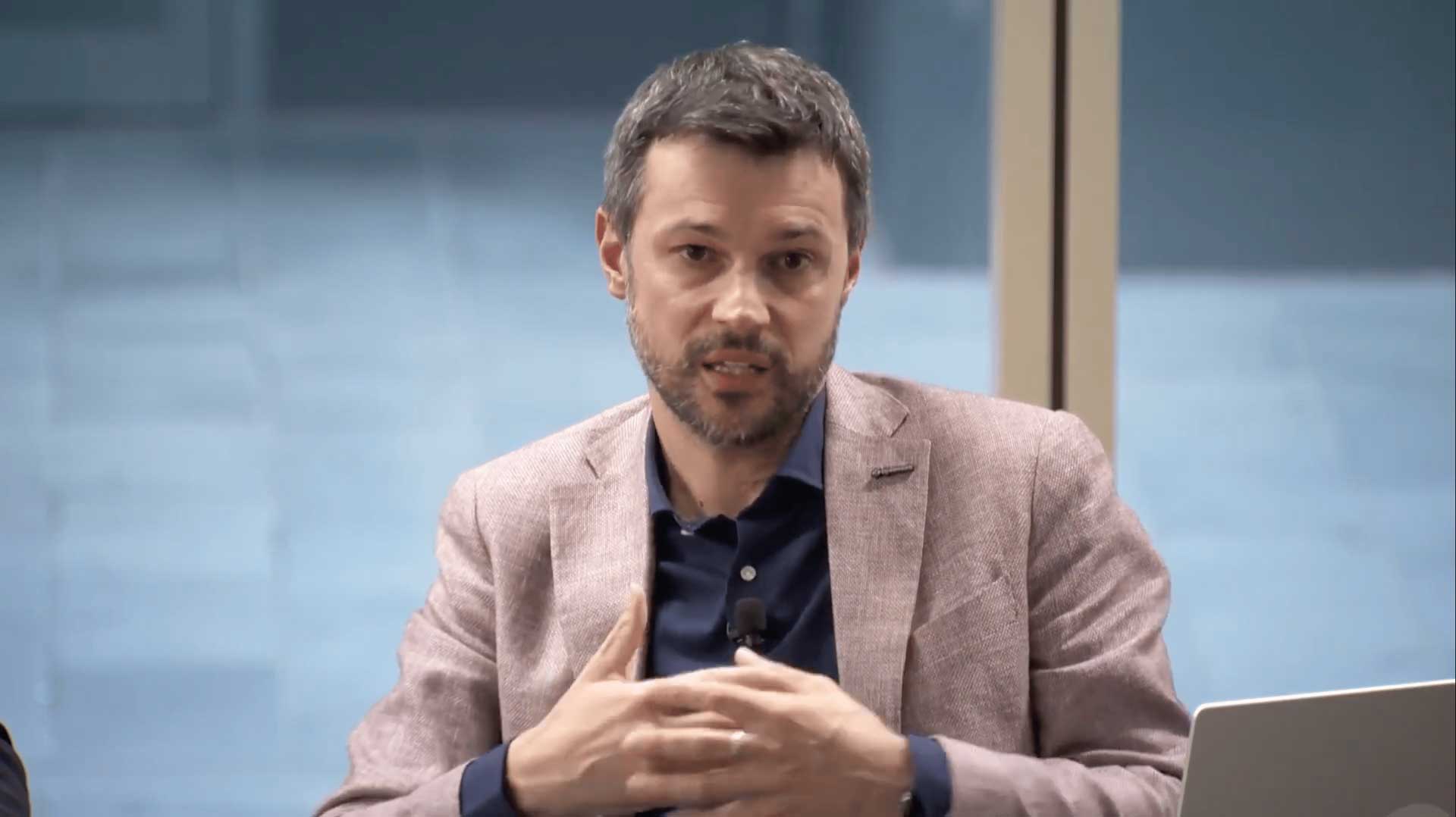Process mining is a family of data-driven techniques to analyze business processes using event data extracted from information systems like Enterprise Resource Planning programs (ERPs) and Customer Relationship Management systems (CRMs). Process mining allows business users to identify bottlenecks, rework, deviations, and sources of waste in their processes, and to discover opportunities to optimize performance and to maximize positive business outcomes.
Over the past decade, process mining has become an essential business intelligence and business process management toolset. Process mining is used in almost all industry sectors, including banking and financial services, telecommunications, energy, healthcare, logistics and manufacturing.
Process mining applications allow analysts and business managers to:
- Understand how business operations are executed by discovering “as-is” process diagrams based on event data from an IT system.
- Analyze data to identify friction points in a business process and relate these friction points with key performance indicators.
- Understand what contributes to desirable and undesirable process outcomes, for example the different activities that contribute to orders that are delivered on-time versus orders that are delivered late.
- Identify non-compliant behavior, understand the root causes of deviations, and quantify the impact of these deviations on process performance.
- Predict the future performance of a process under different scenarios so that teams can make better decisions and better prioritize process automation and process improvement efforts.

How does process mining work?
The process mining methodology is simple at its core: it’s about analyzing data from an enterprise system to evaluate the efficiency, quality and conformance of process flows across an entire process.
The term process mining is an umbrella term for a combination of data mining and process management techniques that use advanced algorithms, machine learning, and statistical methods to analyze event data in order to shed light into business operations, all the way from end-to-end processes to individual process steps. These so-called event logs are simply “log books” of information, collection of records and data.
Process mining uses data recorded in a company’s IT systems as a starting point to identify inefficiencies in business processes, understand their root causes, and estimate their impact on key performance indicators.
Process mining complements other techniques for business analytics, such as data mining. Data mining is a set of techniques to sift through raw data to find useful and pertinent patterns. Before the process mining begins, data mining may be used to make sense of the data.
However, data mining does not provide an end-to-end view of the business process, including bottlenecks, capacity constraints, and rework loops. This is because data mining techniques are not “process-aware.”
In contrast, process mining allows business users to extract visual process maps and models of their processes from IT systems data, and to enhance these process maps and models to bring forward the inefficiencies, sources of delay, rework, and defects, and other operational pain points that lead to inefficient processes. Process mining additionally allow business users to become “compliance detectives” by surfacing out deviations with respect to business rules and norms.
A common example of an end-to-end process is the “order-to-cash process” (O2C), where customers buy goods from a vendor. This process consists of steps such as receiving a purchase order from a customer, delivering the required products or services, issuing an invoice and clearing the payment. At first glance, this process might look straightforward and linear. However, when applied to an O2C process, process mining shows that the actual process is riddled with exceptions, compliance violations, inefficiencies, redundancies, and rework loops, as well as numerous opportunities for process automation. These exceptions can impact business performance and customer satisfaction, leading to higher costs and lost revenue.
If you’d like to learn more about the specifics of process mining, you can read more in our online 90 minute tutorial – Process Mining 101.
Why process mining now?
Process mining is important because it leverages event log data to identify trends, to optimize performance and to make predictions under multiple “what-if” scenarios.
If existing processes are inefficient, this leads to frustrations, missed deadlines, poor compliance, missed opportunities and a decrease in profits, growth and overall morale. Process mining allows analysts to discover how the new process model should look like to address these friction points.
All companies generate data — but not all harness its full potential. Process mining tools automate the analysis of processes, to give you a factual picture of your operations and pinpoint frictions — helping to reduce costs while enhancing customer experience.
By using process mining, a company can take “X-Rays” of their operational processes regularly to implement continuous process improvement initiatives. The continuous improvement cycle that process mining enables is essential for sustained process efficiency. Check out more process mining use cases here.
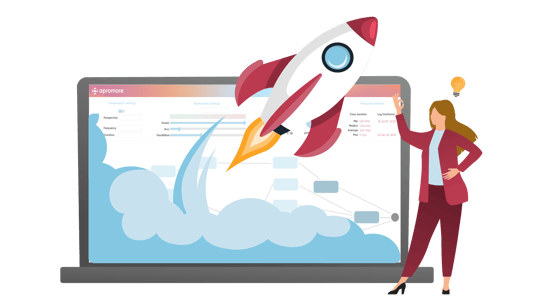
How does process mining relate to BPM?
Business process mining enables business stakeholders to analyze data in order to enhance operational performance, to streamline their processes, and to discover process deviations that occur in a process and how they affect the running of a business.
Applying process mining to business process management (BPM) is becoming an essential part of how companies do business, as it allows them to study process models and log data, and use that information to set up a process mining manifesto, which outlines future automation initiatives, root cause analysis and identifies improvements which can be made to any existing process. Under the hood, process mining uses complex algorithms which is why it is essential for companies to approach their process mining efforts with an appropriate user-friendly tool.
Types of process mining
Process mining tools provide four core capabilities: automated process discovery, conformance checking, performance mining, and variant analysis. These core process mining capabilities are complemented with other capabilities for data extraction and preparation, as well as functionality to construct digital process twins for what-if analysis.
The usual steps in a process mining project are as follows:
- Extract data from one or more enterprise systems, check the data quality, and prepare an event log. In this step, we may need to apply privacy-enhancing technologies to protect personal data.
- Understand the process and analyze its deviations with respect to compliance rules or a reference model (Discovery & Conformance)
- Identify and analyze inefficiencies and friction points (performance mining and variant analysis)
- Discover automation and improvement opportunities, design multiple what-if scenarios, and test their effectiveness using a digital twin of the process discovered from the event data.
Automated process discovery
Automated process discovery takes an event log and produces an “as-is” model, which indicates exactly how the actual process is functioning and allows for comparison with how the company wants the process to do. Process mining allows companies to visualize the process, and understand where there are problems and how can the process be enhanced via automation or other improvement efforts.
Automated process discovery shows the actual process flow, the points where decisions are made, where interventions are made, by whom, where there is a rework and redundant work, and where handoffs happen between employees. The automated discovery step of process mining is crucial to achieve process transparency, which is a pre-requisite for building a process improvement plan.
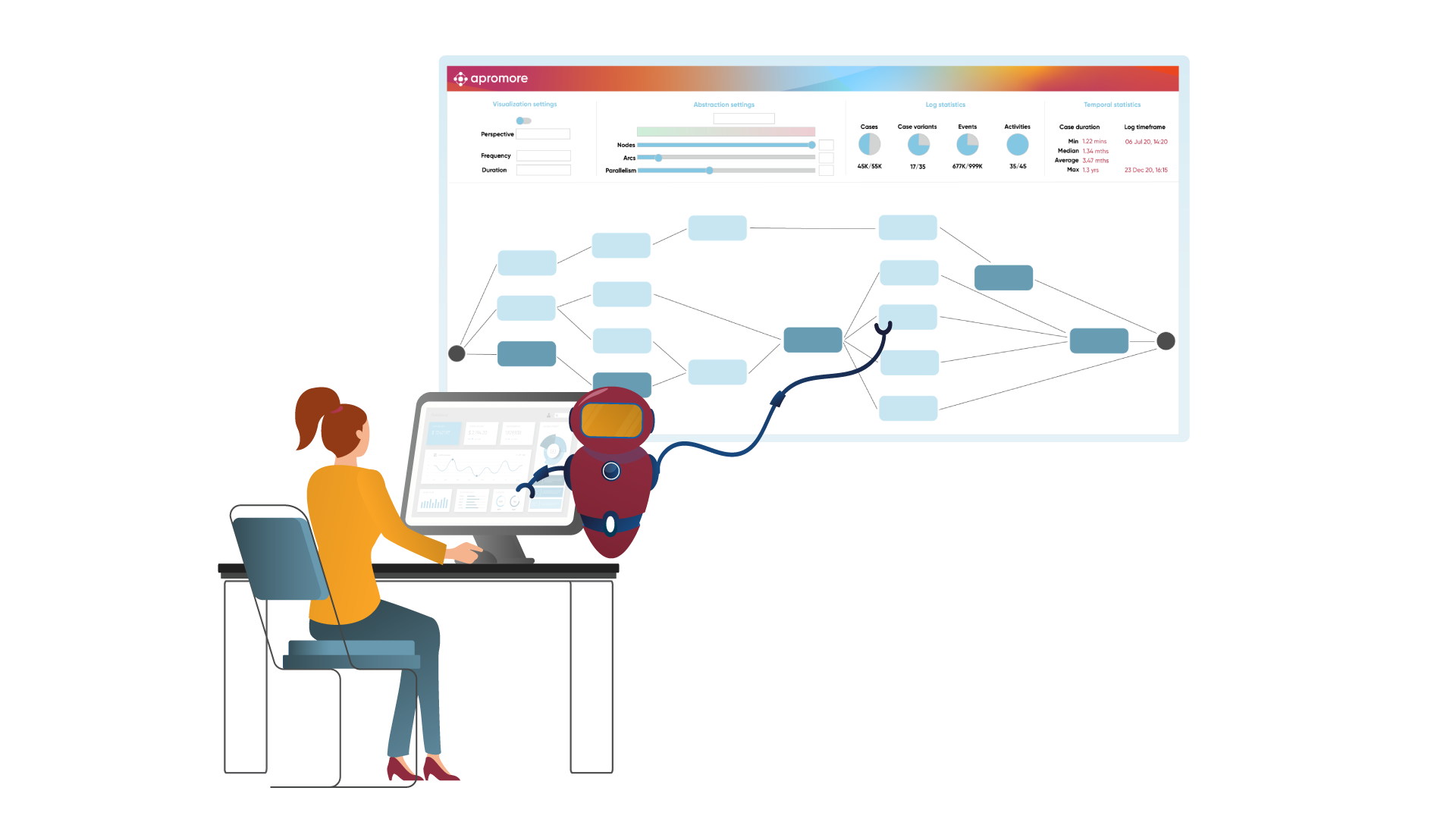
Conformance checking
Conformance checking is the component of process mining work where an investigation is conducted to detect whether the business processes being recorded in the system conforms with the applicable business rules, regulations, and norms. For example, conformance checking allows us to detect deviations between the actual process and a reference process model. It also allows us to detect violations of compliance rules. For example, in a purchase-to-pay process, conformance checking allows us to isolate instances where an invoice is approved and paid by the same employee, in violation of the “four-eyes” principle.

Performance mining
Performance mining is about analyzing the performance of the process from several perspectives in order to uncover what process steps, process flows, and other elements of a process needs most attention or deserve an investment into automation. This is achieved with model enhancement. Model enhancement means that a process model is extended or annotated with performance measures. Model enhancement puts into evidence problematic process flows, bottlenecks, costly and time-consuming process steps, rework loops, prematurely aborted cases, and other friction points.
Process performance mining is the subset of process mining that focuses on questions like:
- Where are the bottlenecks in the existing process?
- Which activities consume the highest amount of effort?
- How is the performance affected when the workload is higher than usual?
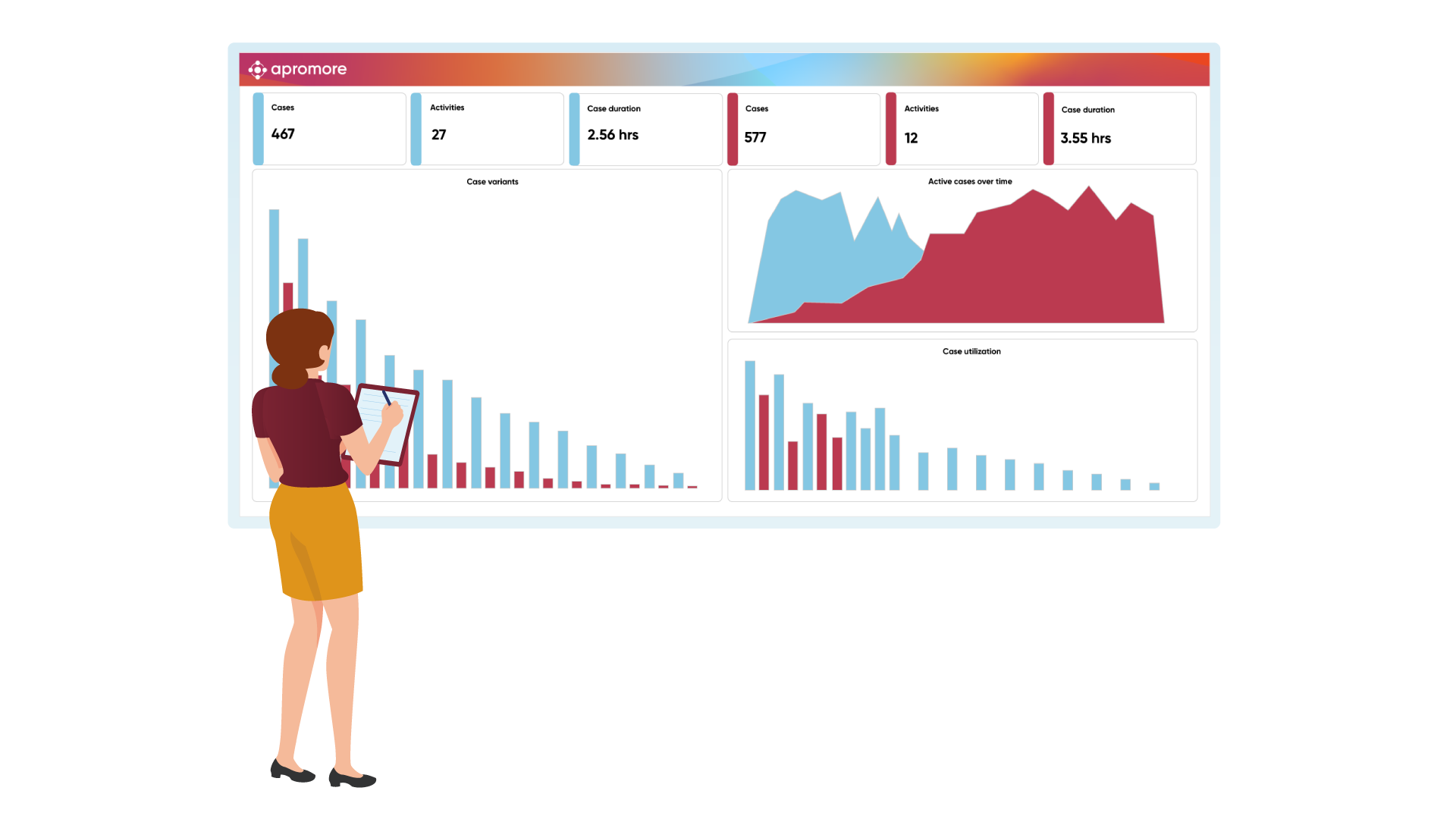
Variant analysis
Oftentimes, it is not enough to analyze the performance of all cases of a process at once. A lot more can be learned by comparing multiple variants of a process, like for example the variant of a process executed in North America versus Europe. In this way, we can find best practices that explain why a variant of the process performs better than another for a given key performance indicator.
Variant analysis is a process mining approach to compare two or more variants of a process in order to identify positive or negative deviance and to generate ideas for process improvements. A common technique for variant analysis is side-by-side or overlaid process graph visualization. Another technique is comparative multi-log animation, where multiple variants of a process are replayed against a process model simultaneously to put into evidence their differences.
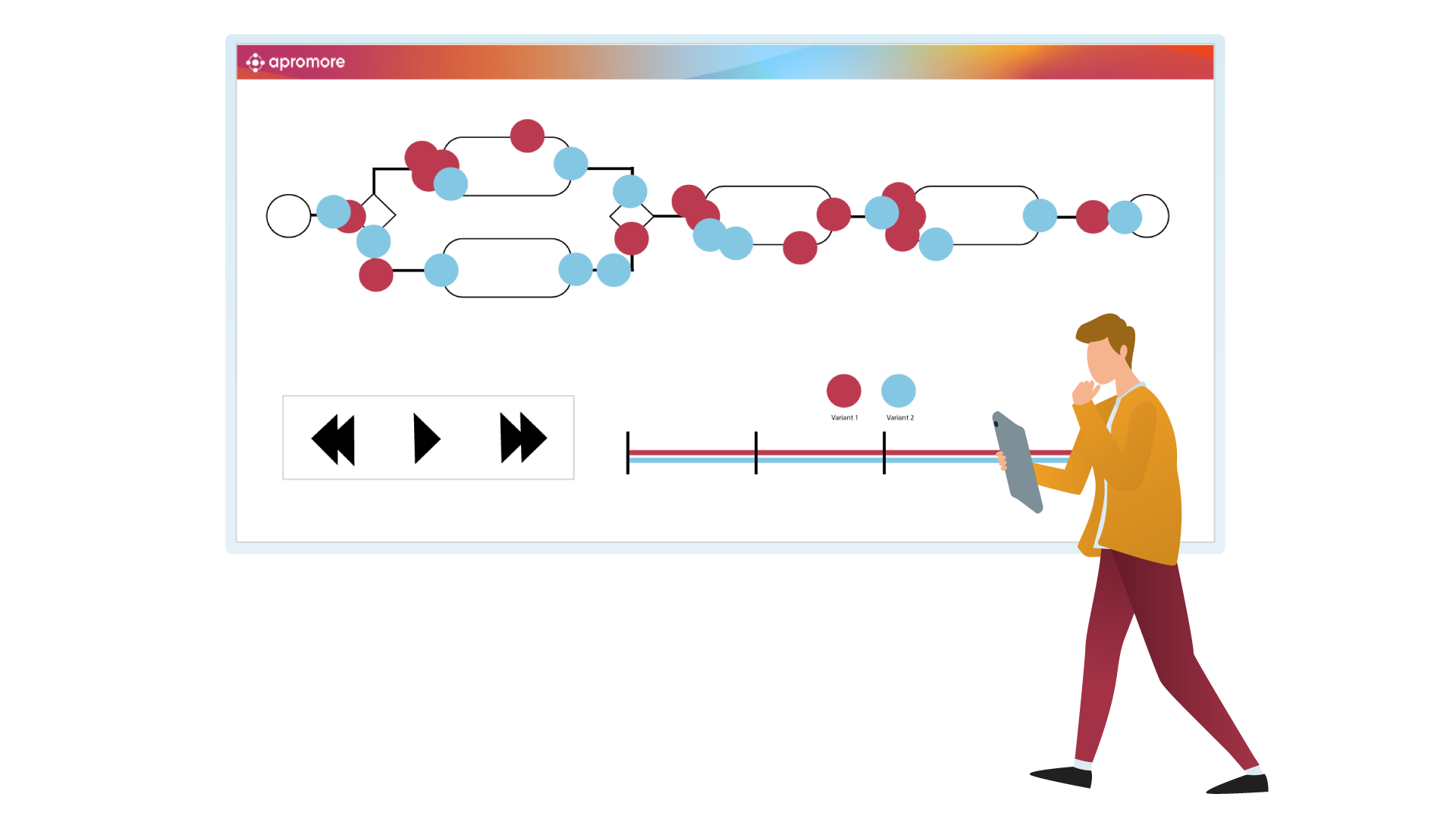
Unlock the full potential of process mining with Apromore
At Apromore, we understand that what makes process mining important is that it allows businesses to completely understand the internal mechanisms of their business processes, how efficiently they are operating, and in what ways they could be improved from start to end.
The Apromore software automatically sifts through the mountains of raw event data to reduce all of that complexity into visual, color-coded, digestible information which meaningfully and accurately depicts the performance measures of the operational business processes via process models and customizable dashboards.
Apromore has a decade of process mining research behind it. It is built upon innovative algorithms designed by world-leading researchers in the field of process mining. The software is strongly focused on AI-driven improvement, while providing a smooth user experience, access to a variety of data sources and, importantly, a flexible and competitive pricing model for all process analytics needs.
Apromore also incorporates machine learning methods to build models to make predictions quickly and in real-time. By leveraging process mining and machine learning together, companies can achieve process optimization both at the tactical level and at the operational level, so that deviations, undesirable business outcomes and SLA violations can be preempted and avoided. This combination enhances the space of process mining use cases across the organization.
Explore Apromore’s state-of-the-art features in more detail.
Learn more about process mining and its vast benefits by checking out our whitepapers.
Questions?
Ask an expert.
Get a personalized demo to see how Apromore can work for you.
Sign up for a free 30-day trial.
No strings attached.



